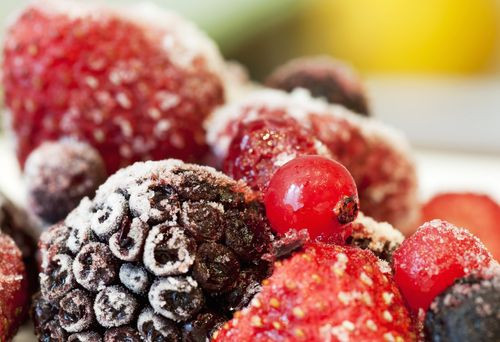Healthy Eating: Learn Myths And Facts About Microwaving, Freezing, And Killing Your Food's Nutrition

Most of us try to eat healthy every day, but what if the fruit and vegetables we're consuming are already damaged by the time they land on our plate? Knowing the process of your food, how it's cooked, and if there are ingredients added is important to make the most out of your food while keeping your body safe from harm's way.
Just throwing it in the microwave to heat up your bowl of rice and vegetables or to defrost frozen strawberries seems so natural, normal, and easy, but it's important to know what it's doing to your food. Ever since the first microwave oven was sold in 1946, people have been wary of the World War II-inspired radar technology that made it possible to cook food. It was as heavy and large as a refrigerator, and with its relatively expensive price tag, owning a microwave oven became a marker of upper class. Today, almost every American home has one, but the fear never left people, and most still believe it wreaks havoc on their food's nutrition.
Nutrients break down whether they're exposed to heat from a microwave or from the inside of an oven, according to Harvard Medical School. When it comes to vegetables, some nutrients do break down if they're surrounded by water during the cooking process. The nutrients will leach into the cooking water, such as boiled broccoli's loss of glucosinolate, the compound that gives vegetables their cancer-fighting abilities. If there is genuine concern on the loss of that compound, the boiled nutrient-rich vegetable water can be reused and incorporated into sauces and soups.
Microwave doubtfuls have also claimed microwaves rob the healthfulness of nutrients and ruin the calorie count in proteins, carbohydrates, and fats. It is true that it does slightly decrease the value of a protein, such as chicken, by microwaving it, but it barely makes a nutritionally significant dent in the grand scheme of things.
When it comes to the nutrition value of food once it's been frozen, the rumors are true; the nutrients in fruits and vegetables do degrade after purchasing and passing time in your freezer. In order to avoid this from happening, buy fruits and vegetables that are sold at peak ripeness: when they're in season, such as purchasing frozen strawberries at their peak in June, or buy them fresh and freeze them yourself. When fruits and vegetables are in season and at their peak, they're nutrient-packed and ready to eat.
As a rule of thumb, when you decide to eat your frozen foods, make sure to steam or microwave instead of boil them back to life in order to avoid losing water-soluble nutrients into the cooking water. Another concern is the loss of nutrients before the foods are even frozen, which is the blanching process. To blanch a food means to boil or steam briefly but not fully cook, and it's an essential step to freezing vegetables such as broccoli, leafy greens, string beans, okra, and asparagus. Blanching actually stops the enzymatic activity that causes decay in vegetables, and by freezing the enzyme, it helps the food, along with its nutrients, survive the weeks or months of freezing. The blanching process robs the food of roughly 25 percent of its vitamin C, folate, and 10 percent of thiamin B1 vitamin; however, the percentages vary greatly.
Another process many question is the dried fruit versus fresh fruit debate. Fruit is primarily consumed for its antioxidants and high fiber content, aside from its delicious sweetness. Dried fruit is really just fresh fruit that has had its moisture removed, which helps preserve it longer than fresh fruit. If fruit is boiled, then dried naturally, it will contain all of the vitamins and minerals that you would find in fresh fruit, in addition to killing microorganisms from the boiling process.
In certain processes, dried fruit can be chemically preserved using sulfur dioxide and will be listed under the ingredients, but the process does reduce certain vitamins, such as vitamin B. Also check the nutrient label to see if there's added sugar and how high it's listed under the ingredients. Fruit has its own naturally-occuring sugar, so there's no reason more sugar needs to be added to it.
Whether you're snacking on dried apricots or decide to buy a fresh one isn't of great concern, but it's when choosing which has the least amount of chemicals and the highest concentration of nutrients that should be of priority. There are several fruits that are more susceptible to pesticides than others and will have you unknowingly consuming a chemical cocktail when you think you're eating healthily. The top pesticide-containing fruits and vegetables are celery, peaches, strawberries, apples, domestic blueberries, nectarines, sweet bell peppers, spinach, kale, collard greens, cherries, potatoes, imported grapes, and lettuce, according to a report by the President's Cancer Panel. By avoiding the consumption of these fruits and veggies non-organically, it can reduce the amount of daily toxins you eat by as much as 80 percent.
Thankfully, there is a long list of fruits and vegetables that are safe to consume whether they're organic or not, and they include: onions, sweet onions, avocados, sweet corn, pineapples, mango, sweet peas, asparagus, kiwi, cabbage, eggplant, cantaloupe, watermelon, grapefruit, and sweet potatoes. It's the different outer layers of skin that makes one fruit or vegetable safer than another.
Freezing, boiling, blanching, or microwaving food all has its upsides and downsides to it, but turning down the opportunity to eat vegetables just because of fear they're frozen is the most nutritionally robbing of them all.



























